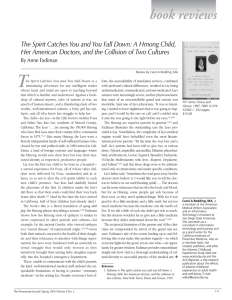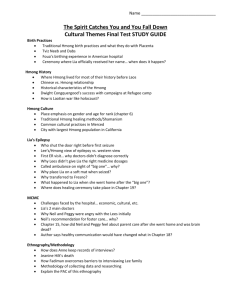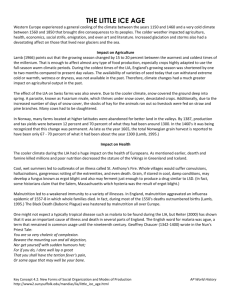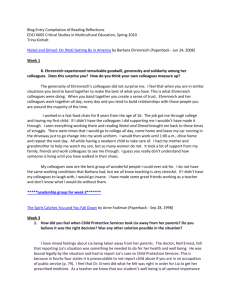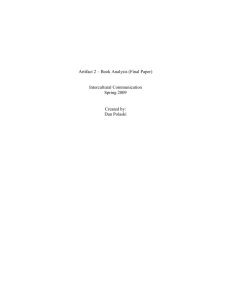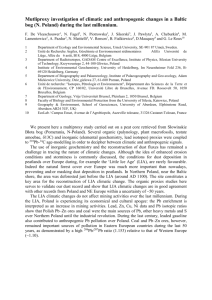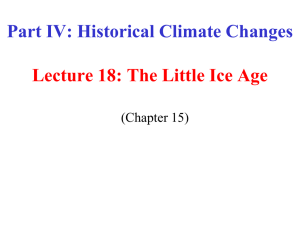Blog Entry Compilation
advertisement
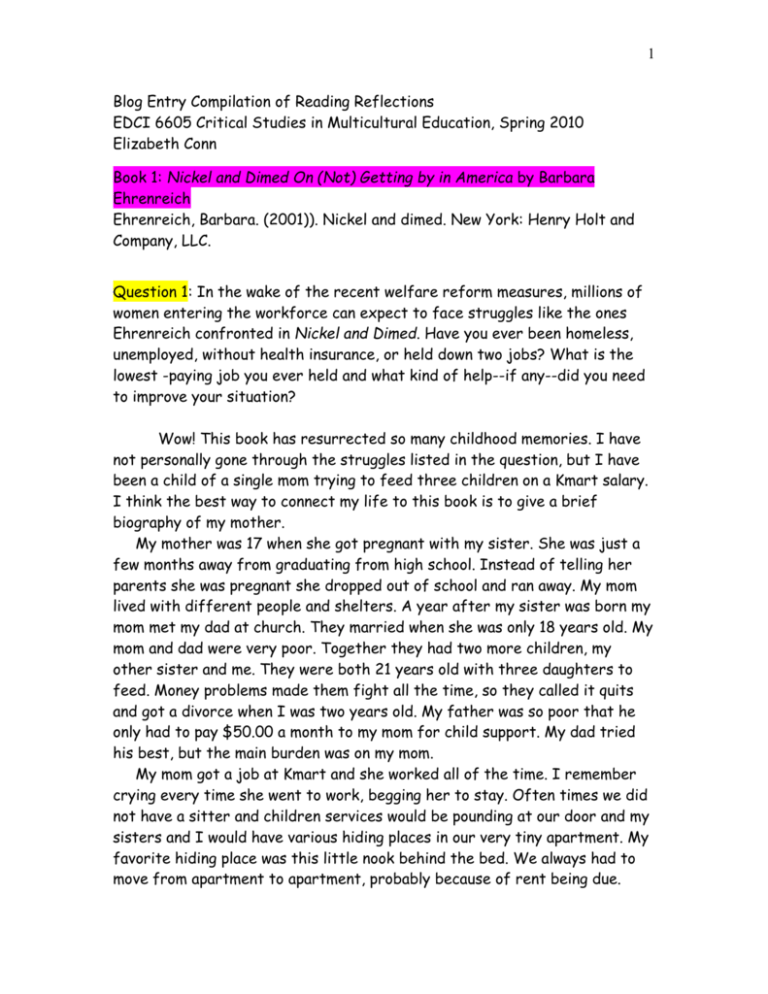
1 Blog Entry Compilation of Reading Reflections EDCI 6605 Critical Studies in Multicultural Education, Spring 2010 Elizabeth Conn Book 1: Nickel and Dimed On (Not) Getting by in America by Barbara Ehrenreich Ehrenreich, Barbara. (2001)). Nickel and dimed. New York: Henry Holt and Company, LLC. Question 1: In the wake of the recent welfare reform measures, millions of women entering the workforce can expect to face struggles like the ones Ehrenreich confronted in Nickel and Dimed. Have you ever been homeless, unemployed, without health insurance, or held down two jobs? What is the lowest -paying job you ever held and what kind of help--if any--did you need to improve your situation? Wow! This book has resurrected so many childhood memories. I have not personally gone through the struggles listed in the question, but I have been a child of a single mom trying to feed three children on a Kmart salary. I think the best way to connect my life to this book is to give a brief biography of my mother. My mother was 17 when she got pregnant with my sister. She was just a few months away from graduating from high school. Instead of telling her parents she was pregnant she dropped out of school and ran away. My mom lived with different people and shelters. A year after my sister was born my mom met my dad at church. They married when she was only 18 years old. My mom and dad were very poor. Together they had two more children, my other sister and me. They were both 21 years old with three daughters to feed. Money problems made them fight all the time, so they called it quits and got a divorce when I was two years old. My father was so poor that he only had to pay $50.00 a month to my mom for child support. My dad tried his best, but the main burden was on my mom. My mom got a job at Kmart and she worked all of the time. I remember crying every time she went to work, begging her to stay. Often times we did not have a sitter and children services would be pounding at our door and my sisters and I would have various hiding places in our very tiny apartment. My favorite hiding place was this little nook behind the bed. We always had to move from apartment to apartment, probably because of rent being due. 2 I also remember my mom being so skinny. This is where I really connected with the story when on p.96 Ehrenreich described Holly as being only 92 lbs. and pale and undernourished on p. 98. As I was reading these lines I saw a picture of my own mother. Tears came to my eyes, because I saw my mother clearly for the first time in my life. I always thought she had an anorexia disorder, because when I was younger she would always skip meals. Her bones were bulging out of her skin and she was so terribly pale. My sisters and I often ate mac and cheese with 1/2 cup of milk to drink. I still only poor half a glass just out of habit, but this what my mom did in order to meet our needs. She would limit us to 1/2 cup of milk, but she herself would do without. I have so much more understanding and gratitude towards her now. I used to call her a fighting Chihuahua. She was always so weak looking, but I remember her fighting so clearly when I broke my arm. She was yelling at the top of her lungs in the hospital demanding I get taken care of even though we did not have health insurance. She must have made enough noise, because I ended up having a very involved elbow surgery at Cincinnati Children's Hospital. I realize now that she had to fight for everything. My childhood Christmases were spent at the Salvation Army where we would get one present, food and a nice winter coat. One time I got a horse head on a stick and I thought it was the most wonderful present. Clothes were another issue. Often I would grow out of my clothes in height (not weight) so my jeans would become capris and then eventually my mom would turn them into shorts. I have so many school memories of other children laughing at my clothes or rather my lack of clothes. Eventually, my mom married a not-so-nice middle class man when I was 8 who promised she would not have to work and we would all live comfortably. Well, that was a big fat lie, but she did start working as a payroll accountant. My mother has successfully graduated 2 out of 3 of her children from both high school and college. She herself has worked the same accounting job for almost 20 years, and recently returned to college to earn her bachelor's degree in ministry. She is a preacher now and promises me that the only thing that got her through was her faith in God. I believe her, because I can't imagine how anyone could fight all of those battles alone. My mom's blood, sweat, backaches, and devotion to her children has given me a very good life. I am so thankful for my mother and now for reading this book, because I have a greater appreciation for what my mom had to do in order to keep all of us breathing. 3 I wanted to note a very interesting thing according to James P. Brynes, the author of Cognitive Development and Learning in Instructional Contexts, I should not have been a good reader, because my parents were not well educated and we were poor. I guess all I can say is that thankfully statistics can sometimes be wrong. :) Question 2: Why do you think low-wage workers are reluctant to form labor organizations as Ehrenreich discovered at Wal-Mart? How do you think employees should lobby to improve working conditions? I think low-wage workers are reluctant to form labor organizations for several reasons (please remember these are just some theories): Afraid of losing job-- Barbara Ehrenreich mentions throughout Nickel and Dimed that workers were afraid to miss work for even a severe injury, because it would mean they would not be able to buy groceries. Ehrenreich also noted how the employees of Wal-mart who sued for overtime had gotten fired for minor offenses such as being caught cussing. Employees knew if they made any noise they would lose their jobs, which meant their families would go hungry. Ultimately, they felt like they had no choice, but to suffer through mistreatment and pain. Lack of power--I got the impression that maybe the people she wrote about felt powerless. If no one felt like they could make a difference even in large numbers, then they did not have an advocate. If Ehreneich stayed an provided awareness and historic examples, I bet some people would have marched with her. I still think so many workers would have not tried due to fear and the feeling of being powerless. Union wages--In another part of the book, Ehreneich mentioned how Walmart denounced unions. Also, people were afraid of having to pay the union wages. Again, low-wage workers are left feeling powerless and stuck. I believe it is possible low-wage workers to fight back. They could organize, because their numbers definitely outnumber those who pay them. Also, I think it is going to take some already powerful people opening their eyes to the pain and suffering they are causing the low-wage workers and their families, and then doing something about it. If low-wage workers want to march I will be right there with them in support. :) Question 3: After reading Nickel and Dimed, do you think that having a job - any job -- is better than no job at all? Did this book make you feel angry? 4 Better informed? Relieved that someone has finally described your experience? Galvanized to do something? Prior to reading this book, I did think having a job any job was more respectful than not. I have always looked at Welfare negatively, because I was surrounded by people who lived on it. Throughout my childhood I heard family members arguing that people who were on Welfare were just lazy and lacked initiative. The negative views that I overheard about Welfare made me think that people could do better with themselves if they would just try to work. My sister has 3 children (had 4, but her son died of SIDS when he was 3 months old), and I have always been kind of embarrassed that she was on Welfare. I would always try to talk her into getting a job or going back to school. Honestly, I thought she was just being lazy. After reading this book and the blogs of our classmates, I see that she was probably making the better choice. Should she be gone from her children all day scrubbing floors and/or toilets just to break down her body and still hardly be able to feed her children? By no means do I think she should be rewarded for not working, but I am just saying can I blame her? This book has made me feel angry towards myself for being so ungrateful for all of the things my mother did for me and for being so materialistic. My husband and I are trying to live on my teaching salary alone and we have had to cut a lot of stuff out. Being stingy with our money has made us both crabby, because we can't just buy what we want. Nickel and Dimed stopped me in my tracks and made me think about a lot of things. The major thing is that I get to teach, which I love, and still make enough money to keep food in our babies' bellies. Yes, I am angry at myself for misunderstanding poverty even after I lived through poverty as a child. I am also angry at our government. How can their surveys be so blind sided that they do not see what is going on? People who work are starving without any sick days, insurance, and etc…This is just wrong. I feel so much more informed about the poverty issue and I have so much more empathy for people like my sister. I wish I could take back some of the things I have thought about her. This reading has really led me to investigate more about my students. I recently learned that one of my students does not have a bedroom and he has to sleep on the floor. Another student told me that he hears people arguing outside his window at night in the apartment building where he lives. He said he is so afraid that they might get him that he sets up a fort around his bed each night (He is pretty 5 imaginative, so I don't know if this is true or not). During my class meeting we talked about when I was a child and being poor. My reading class has only 17 children who mostly come from divorced homes and low income families. They were bursting with info and so many of them had their own sad stories to tell. What am I going to do about it? Well, I started by sharing this book with a co-worker. I'm not sure what I am going to do, but I really want to do something. Maybe just being aware of the poverty issues can help me reach my little first graders and make in turn make me a better teacher. Book 2: The Spirit Catches You and You Fall Down by Anne Fadiman Fadiman, Anne. (1997). The spirit catches you and you fall down. Farrar, Canada: Douglas and McIntrye Ltd. Question 1: Were you surprised at the quality of care and the love and affection given to Lia by her foster parents? How did Lia's foster parents feel about Lia's biological parents? Was foster care ultimately to Lia' s benefit or detriment? First of all I was appalled that Lia was removed from her parents without trying a different method, such as an HMO. I can see that Dr. Ernst did not understand her parent, nor did he try. He was just focused on Lia's illness. Whatever the cause Lia ended up with Dee and Tom Korda. Dee had to be a very dedicated mother and foster mother. I cannot believe that she had an 9 month-old infant of her own and was pregnant when Lia came to live with them. I was shocked that she nursed Lia along side her own child. I nursed my two children and it was a very special thing, but I can't imagine nursing a child who was not mine. If I were a foster mother I would try very hard to make the child happy, but I could not have done that. Nursing is also exhausting, so I cannot wrap my mind around that she had several children of her own, nursing two children, and being pregnant, while taking care of the families needs and Lia's regimented medicine schedule. I wish I could know what Dee was thinking we she enrolled to be a foster parent. Dee really seemed to be there for the children she fostered. She kept a book of photos for each child. From the reading, I pictured Dee as a strong woman who wanted Lia to be happy and healthy. She tried to do things the way Foua did including carrying Lia on her back. I think Dee's 6 willingness to try to do things like Foua created a bond between the two mothers. I'm glad that the Lee's actually had Dee on their side. I think that the foster care was unnecessary. Ultimately, I feel that Dee did such a good job keeping the medicine in Lia like she was supposed to that Lia's body probably went through withdraw when Nao and Foua did not administer the drugs during the week long stay. I can only speculate that if Lia had never had the medicine like she was supposed to then she would not have experienced this withdraw, which may have caused the major seizures. I think the best option would have been a home health care nurse stay with the family as well as a Hmong translator. The nurse could have taught the family how to administer the meds, and then be to make sure they did it correctly. The inabilities to cross the cultural beliefs really lead to Lia's detriment. This story is exhausting and excruciating to read. I keep asking myself "what would I have done?" It is a very trying topic. I can't wait to finish the book. Question 2: Dr. Roger Fife is liked by the Hmong because, in their words, he "doesn't cut" (p. 76). He is not highly regarded by some of the other doctors, however. One resident went so far as to say, "He's a little thick." What do you think of Dr. Fife? What are his strengths and weaknesses? The author also speaks of other doctors who were able to communicate with the Hmong. How were they able to do so? What might be learned from this? I think Dr. Fife was right on the ball. The other doctors did not like him, because his practices were different than their own. Dr. Fife's strengths were that he did not judge and he tried to do what the patient would prefer. Dr. Fife did not question why the Hmong requested the placenta, he felt that it was theirs and they can do what they want with it. I'm paraphrasing but he said something like “its their body they can do what they want with it..." I think Dr. Fife's ability to let the patient have some control really helped the Hmong people like him. Hmong are definitely a people who want to be in control of their lives. I'm sure Dr. Fife did have some weaknesses like all humans do, but I did not get anything from the reading that made me think he was not a good doctor, besides the other doctors call him "thick". Fidaman mentions some other people who were able to communicate with the Hmong. I think one charatistic trait that these people had in common was their willingless to try reach the Hmong people by learning parts 7 of the Hmong beliefs and culture. Just like the Dwight Conquergood, ethnographer for Ban Vinai, put on a parade in order to get dogs vaccinated. He linked what needed to be done with something the Hmong people already did in their culture. I think we all can learn to take a closer look at the world around us. We all need to realize that we may share the world, but it is a huge place and so many different things can and do happen that affects how people develop. As educators we need to find out not only where are children are coming from, but also about their parents. We need to know our students evening routines, so we can reach them. We need to connect with their beliefs, so that we can do what Conquergood did and put on a parade or whatever to help our students! I also believe we need to be less judgmental on all people, because we don't know what they have gone through. Question 3: How did the EMT's and the doctors respond to what Neil referred to as Lia 's "big one"? Do you think they performed as well as they could have under the circumstances? First of all I would like to account for the 20 minutes lost, because the Lee's decided to have an ambulance come get Lia instead of taking her the three blocks themselves. I understand their reasoning that the hospital was quicker to respond when a patient came in an ambulance. The EMT who was trying to help Lia was "in over his head" and by trying to help her himself lost 14 minutes of critical time. I can't help thinking some of what happened could have been prevented if they would have just ran like crazy and got her to the hospital. I think the EMT should have loaded Lia up and got her to the hospital as fast as possible. My personal opinion of the doctors is both positive and negative. I think they did what they could to help Lia. I am shocked that the doctors did not insist on a temperature reading after the seizures subsided. In the book Anne Fadiman tells how Lia's seizures were almost always fever induced, so why didn't the doctors make sure she did not have a fever? I am aware of how wild that emergency room had to have been and how the procedure of taking a patient's temperature could be overlooked, but her vitals should have been checked after the seizures stopped. I have also been questioning why they did not try to find out what caused the seizures this time? Was Dr. Neil preoccupied with his trip or had he just become so disassociated that he did not care? The Lee's blame the doctors in Fresno for her "losing her soul", 8 but I think the doctors at Freson were very thorough with finding the cause of her ailments. I wonder if Lia's life would have been different if the Lee's had moved to Fresno instead of Merced. My opinion is YES! Question 4: What did you learn from this book? Would you assign blame for Lia 's tragedy? If so, to whom? What do you think Anne Fadiman feels about this question? First of all, I have learned so much about the Hmong people and their culture. I am embarrassed to say that I was completely unaware of these people and their struggles. I generally say that I live in a bubble, because I am so focused on my family and teaching. I guess I really am in a bubble and I need to be more aware of the world around me. This book has also really corroborated everything that Shawnee State Teacher Ed tried to instill in me about BACKGROUND KNOWLEDGE. A person who has to help and work with other people such as educators, doctors, social workers, and etc. should get to know the people they are working with and where those people are coming from. Lia's story is very tragic and it is hard to assign blame to one particular side. Each decision made by the doctors could have been thought through more if they were being sensitive to the Lee's beliefs and wishes, but at the same time the Lee's noncompliance with the medicine also complicated things. Ultimately, both parties made some good choices and also some poor choices. I do believe Lia could have had a different outcome if the doctors and the Lee's were able to communicate more efficiently. The Lee's never trusted the doctors and the doctors never trusted the Lee's. The lack of trust and the lack of trying to find respect for the other party caused by the cultural differences is the culprit of Lia's tragedy. I inferred during the reading that Anne Fadiman believes the cultural boundaries and the lack of trying to reach one another is the true reason for Lia's demise. Her questions at the end gave me a lot of answers. I was shocked to hear that Jeanine Hilt ended up having the same condition as Lia after her asthma attack. Also, the opinion of Dr. Hutchinson raises even more questions. Fadiman said she thinks Lia would have died in infancy if they were still in Laos, but I am not so certain. The Lee's seem to have an endearing love for their children and maybe they would have been able to help Lia using their medicines. Who knows? This was a very interesting story and I have mixed emotions about it. I am glad that I read this book, because 9 I have learned a lot. I am sadden by the struggles of the Hmong people and how Americans have and still are treating them. I am extremely heartsick for the Lee family and all those who helped care for Lia. I guess Lia did meet her family's expectations. She did turn out to help other Hmong people, maybe she is not a txiv neeb but her life story has provided many valuable lessons. Hopefully, all readers will learn and change from this book. Book 3:White Teacher by Vivian Gussin Paley Vivian Gussin Paley. (1989). 2nd ed. White teacher. Cambridge: Harvard University Press Question 1: How was Mrs. Albright's teaching ethics different from Mrs. Paley's? Why did Mrs. Albright chose not to work in a school where the classes were mixed rather than filled with black children? Mrs. Albright was not afraid of a child's ethnicity, so she did not ignore differences. Mrs. Albright embraced each child for who he/she was. Mrs. Albright used what the children were thinking and went with it to create a comfortable environment where everyone could be different but still accepted. I love the way that Albright helped Paley understand how even though she was trying to be compassionate for black children that she was still creating prejudices, because Paley was too afraid to really accept them. This book has really helped me, because in a way I relate with Mrs. Paley. There have been a lot of issues that I have wanted to talk about with my students but have been terrified to do so. Mrs. Albright kind of let me know that it is okay to talk about things that we may be uncomfortable with. For example, I have a student who chooses not to talk at school. At first I would not let the students talk about her selected mutism. I have really tried everything to relate with this child. Finally, I tried to just ignore her and thought that she would want my attention and try to get it. Well, that didn't work, so I did little things to try to make her more comfortable. First, during class meeting we came up with a list of things we can do so that we all feel more comfortable. Then I started having our group out in the hall. I close my eyes and cover my ears while she whispers to another student who dictates for her after she tapped my knee so I could uncover my eyes and ears. By working with her and seeing her for who she is, I have been able to create a relationship with her. Before, I was trying to do things my way, 10 but as Mrs. Albright and Mrs. Paley have figured out it should be the child's way! The most important thing I take away from this book is...do recognize and draw attention to differences, because that is what makes us who we are! We all want to fit in (somewhere), but at the same time be noticed. I want for my students to notice each other and for me to do the same. Question 2: How does being Jewish affect Mrs. Paley in her opinions and reactions to her students? Does her comparison of growing up a Jewish child to growing up a black child a fair comparison? Explain. I think that Mrs. Paley does have some experience with being different from the majority, which has helped guide her teaching. I think that she recognizes that she has always tried to hide being different and ultimately her own experience has helped her deal with her students' differences. Mrs. Paley did feel different, but she didn't look different. At a point in the book, she states that later in life she found out half of her classmates in grade school were Jewish. The teachers and students did not talk about it, so nobody knew the differences. I do not think it is an entirely fair comparison, because being Jewish could be easily overlooked by a teacher or peers. However, a black person cannot simply choose not to mention the fact that he/she is black, because their difference is their skin not religion. In our earlier reading Nickel and Dimed by Barbara Ehenreich she described a time at a gas station where people would stare at her and look at her disrespectufully, because she was wearing the brightly colored maid shirt. Ehenreich compared how others' made her feel by saying now she knows how a black person felt. Ehenreich was being judged just by the shirt she was wearing...just like black people are judged by their skin color. Mrs. Paley had a valuable experience growing up Jewish with "gentiles" for teachers, because I believe through this she has learned compassion for those who felt different. During the reading, I felt like Mrs. Paley put some blame of her childhood experiences on her parents. They always put down non-Jewish people and they never talked with her about how she felt. Her parents saw her school life as a pleasant time, where Paley did well. Paley saw it as a place where she was different and had to be perfect so she would not stand out. In my opinion if Paley's parents had been more open and tried to make her feel more comfortable with her feelings she would have been able to talk about being different with her students easier. Years of wondering and thinking I should have....could have been avoided and she 11 would have been meeting the needs of her students sooner. Do you think it was a fair comparison? Book 4:The Shame of the Nation: The Restoration of Apartheid Schooling in America Kozol, Jonathan (2005). The shame of the nation: The restoration of apartheid schooling in america. New York, NY: Crown Publishing Group Question 1: Pineapple, a third grade student, asks Kozol what it is like.. over there…where other people are (pp156). What do you think she meant? What does it make you think? Honestly, when I first read this line I thought of The Wizard of Oz. I'm not sure why, but it seemed to me like Pineapple thought over there was some magical place like "somewhere over the rainbow". Pineapple was curious about an element of life that she was aware of, but did not know about. She believed that things were different for white people from "over there". I have really just thought about so many things. For example, I am now think about what it is like for the people over there. However, I am thinking about how life is for children who go to the minority segregated schools. I really did not realize or even think about how education was so different across the nation. I have been in complete shocked while reading and learning about the various conditions these children, parents, and teachers have to fight through. My eyes are definitely more open and I have been trying to be more aware of how I see and treat people. Last week, I was in Columbus for the eTech Ohio Conference. My family went with me and one evening we went to the mall. My sons have always been around black people, because my sister's children are half black. Well, we were at the mall in the playzone area. There was one other child who was probably around 7 and he was black. His mom was watching him. We sat near each other. We both said hi and were watching our children. My 3 year old kept going up to the boy and asking him if he wanted to play. The boy would not look or talk to Brendan. Brendan came to me and asked if the boy was shy. I didn't know how to answer, so I told Brendan to just play with my other son. Just a few minutes later I overheard the boy ask his mom if he was allowed to play with Brendan. His mom shook her head "yes". After that the boy did not go play with Brendan. Brendan went up to him several more times, but was disappointed when he 12 would not answer him. I got the feeling that the boy may have been uncomfortable because Brendan was white...maybe I am just looking too much into things. Anyway, I felt like there was some kind of barrier. Overall, I am saddened by the reading and I feel like our government is really letting so many people down. :( Question 2: Reflect on the "industry-embedded" approach to education in the schools where majority of students are from poor or racial minority backgrounds, as observed by Kozol in Chapter 4. I think Kozol was very saddened by the "industry-embedded" approach in education. Kozol described a kindergarten poster found in one of these schools on pp. 89-90. The posters said things like "Do you want a manager's job? What job do you want? How will you do the manager's job?" The poster is setting kindergartners up for jobs without even offering them a choice. Kindergarten is a time for discovery and learning about oneself. These schools are taking away discovery and telling children that they can't strive to be whatever they want. Adding to this degradation the schools also put logos of different department stores around the school. These very young students are not given hope for change or the knowledge that things can change for them. I remember when I was entering college and during my first meeting with my advisor. I knew that I wanted to be a teacher, but when I told my advisor this she opened my file and read over it for a moment. She looked at me and told me that I did not have the ora to be a teacher and that I should go into the medical field. I was devastated. My whole plan for my future was in a upheaval. I truly believed that this one person could see that I was not meant to teach even though I knew I was supposed to be a teacher. I tried different majors in the medical field and was not happy with any of them. Finally, I went back to my advisor and told her how I felt. I changed my major and I haven't looked back since. My personal story relates to this subject, because I was an adult who had graduated from high school and earned a full ride to college based on my GPA, and one person's opinion of me had me confused about who I was and who I wanted to be. Can you imagine how powerful these "industryembedded" schools' messages can be to these young people starting at kindergarten? If you were told at 5 years-old you were going to be a manager and that was the only choice you were given knowledge about. How would your life today be different? Personally, I was so affected by my 13 teacher's opinions that I would be sitting at a cash register day in and day out instead of getting the privilege to be a teacher. Questions 3 &4: These blog entries were during week seven, which was my leadership group week. I was exempted from these blogs. :) Question 5: 1. What do you think is Kozol's motivation for writing this book? Was the point of the book to share an opinion, explain a topic, tell about a personal journey, or something else? Did the author do it well? I believe Jonathan Kozol wrote this book in order to explain the topic of resegregation in our schools and to motivate people to do something about it. Personally, I was unaware of schools being so segregated. I knew that my school was not very diverse, but I thought it was just the area. I did not realize that schools around the nation were so segregated and that the quality of education and buildings were not equal. After reading this book, I feel like I was very ignorant for not realizing there was a problem. However, I am not taking all of the blame, because our government has not made it an issue. Through this book, Kozol brought to my attention the Harvard study Civil Rights Projecy lead by Professor Gary Orfield. One part of their study reports "In the two largest educational innovations of the past two decadesstandards-based reform and school choice--the one issue of racial segregation and its consequences has been ignored." (p.19-20) I think Kozol realized that the government was not going to make an issue of the apartheid schools and so he took it upon himself to do so. The book seems to encapsulate Kozol's personal journey as a way to tell the story of these children who are being oppressed. Black children and Hispanic children are his focus, but this book has made me look our schools in general. Schools are not equal in our area, either. I think that Justice Thurgood Marshall got it right with Brown v. Board of Education and it is truly a "shame" that we are not fulfilling the details of this ruling. Kozol was very clever and chose the perfect title for this book.
